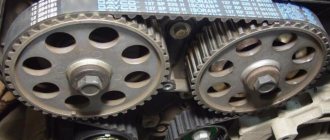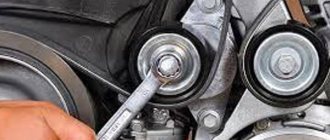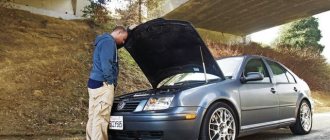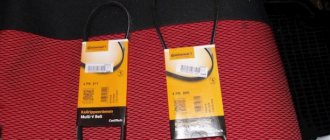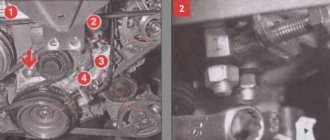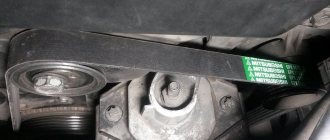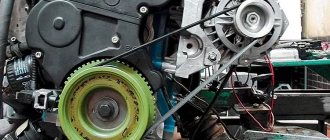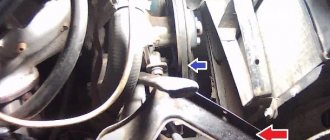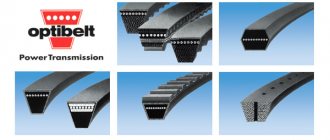In most cases, there is one reason for the appearance of a whistle, squeak, squeak or squeal from under the hood of a car - the alternator belt or timing belt is whistling. On modern cars, in addition to the generator, the drive belt can also rotate the pulleys of the power steering, air conditioning compressor, engine cooling pump and other attachments.
The reasons for whistling may vary. For example, a whistling alternator belt in wet weather can be caused by moisture getting on the belt and pulleys. And if the generator belt whistles when cold, this may be due to thickened lubricant in the generator bearings or tension rollers.
In this article we will talk about why the alternator belt whistles, what to do in such cases, and how to eliminate the drive belt whistle yourself.
The whistling may appear for a while and then disappear (for example, the whistling of the alternator belt when the engine is cold, during rain or when the air conditioner is turned on), or it may be constant. What to do and where to start looking for the cause of the whistle?
Types of hanging belts
Previously, cars were equipped with only one belt; it drove only the generator. In the process of improving engines, the number of power units that need to be driven, for example, the steering wheel and the compressor, increased. Collectively this is called attachments
. In the 21st century, it will no longer surprise anyone that the attachment consists of at least 3 units!
To transfer mechanical energy from the engine to the generator, cars use V-belts and poly-V-belts, the latter being more popular. Let's look at each type and look at their appearance.
V-belt
A belt having a trapezoidal cross-section and resembling a wedge shape, pointed on one side and widening on the other side. This type of belt ensures more efficient operation of the mechanisms and makes the transmission more compact.
V-ribbed belt
The belt, which has longitudinal stripes on the inside resembling wedges, got its name from the Greek “poly” - which means many. This type of belt is very flexible and has excellent traction capacity.
As it was before?
Previously, on cars, the belt drove only one unit - the generator, which simplified the establishment of the cause of the sound (there are only two options - the belt itself or the generator).
With the improvement of power plants, the amount of equipment that is driven by the generator belt has increased and it has already begun to be called an attachment drive.
It is now considered common practice that a flexible transmission simultaneously rotates 3-5 units, not counting the auxiliary elements - bypass and tension rollers, although there are cars in which the element is driven only by a generator, for example, a Lada Priora without air conditioning.
But on the Ford Focus 2, the belt drives the generator, power steering pump and water pump (cooling system pump).
On Reno Logan, the number of driven attachments depends on the configuration - in the simplest version, the belt drives only the generator, on models with power steering the element already “turns” the amplifier pump, and in cars equipped with air conditioning, the drive also turns the climate compressor -systems.
If we take the Hyundai Tucson, then in this crossover the task of the belt already includes driving the generator, power steering pumps and cooling system, as well as the air conditioning compressor.
Belt drive features
Belting
- This is the transmission of mechanical energy using a drive belt.
This design has strengths
including a long service life, accessibility to maintenance and quiet operation. The belt is very strong and flexible, this allows it to be placed between many elements of attachments and set in motion.
Alternator belt using the example of a Lada Priora with air conditioning: 1) drive;
2) tension roller; 3) engine support bracket; 4) generator; 5) air conditioning compressor. However, there are also weaknesses!
The drive is demanding for the correct arrangement of elements, sensitivity to aggressive influences and the quality of the pulley surface.
As they wear out or become damaged, the moving parts experience additional difficulties during rotation, primarily affecting the transmitting torque. Whistling occurs
when the opposing force is too great.
Some tips for increasing the life of your alternator belt
Before and after parking the car for a long time, especially in the warm season, you can slightly “soften” the working area of the belt by lubricating it with a special product or a gasoline-water solution in a 1:2 ratio.
This will prevent the belt from cracking and protect it during routine maintenance. At the same time, make sure that there are no electrical wiring, clamps or rags near the belt.
After driving for a long time on a dusty road, use a compressor to blow through the rotation area of the alternator belt. Check the degree of tension at the beginning of each season, especially in severe frosts.
Remember that too much tension can lead to belt stretching and premature failure.
Why does the whistle appear?
In 90% of cases, belt friction is to blame.
at the moment of slipping. When the belt cannot transfer mechanical energy to the generator pulley, it simply slips, making an unpleasant squeal.
Most motorists make a grave mistake! Remember, you need to look not for the reasons for the unpleasant sound, but for the reasons causing the belt to slip!
Let's list the 5 main causes of slippage in chronological order :
- penetration of moisture, dirt and technical fluids into the mechanism;
- severe wear of the drive belt;
- drive belt of poor quality;
- weak or excessive belt tension;
- misalignment - parallel and angular misalignment are distinguished;
Conclusion
The causes of whistling in the engine are considered. This effect is usually caused by worn parts. To eliminate the problem, you need to replace one of the elements: belt, tensioner, pump or generator parts. Not all car enthusiasts are able to do the process themselves, so it is recommended to contact a car service center.
An experienced driver can determine the cause of the malfunction and how to eliminate it by the sounds of his car. If the belt whistles when you turn on the air conditioner, then most often the problem is related to the V-belt drive. The article discusses the causes of whistling and methods for eliminating it.
Common causes of unpleasant sound
Below we will look at the common reasons
occurrence of an unpleasant sound.
We will not consider specific reasons;
they are specific to specific car models.
General
- depends on external factors and typical faults.
Resource exhausted
Nothing lasts forever, including a belt reinforced with strong threads. Belt drive transmits enormous energy and handles variable loads. Over time, the belt stretches, its surface wears out, the rubber delaminates, and it is negatively affected by environmental factors. The average resource varies from 40,000 to 60,000 kilometers, but much depends on the conditions in which the car is operated.
Dirty surface
Drive surface cleanliness is one of the most important factors affecting belt service life. If the drive is corroded, dust or dirt gets into it, all this acts as a kind of abrasive that reduces adhesion properties and service life.
The most harmful effects are caused by technical, caustic liquids. Rubber is very sensitive to them. The process of aging and destruction accelerates, in addition to this, the friction force decreases, which is why the alternator belt can slip and make an unpleasant sound.
Mounting location
A minimal deviation from the correct position of the pulleys relative to each other will have a detrimental effect on the belt contact patch. Deviations are: vertical-angular, horizontal-angular, parallel. In such a situation, the alternator belt will slip and make a whistling sound.
Please note that if any pulley rotates in a figure eight, it will tear and throw off the generator belt. Most often, pulleys with a rubber damper behave this way, which over time loses elasticity and ceases to perform its functions.
An indirect sign of pulley misalignment is the poly V-belt jumping from track to track and sliding off the pulley.
Belt tension
If the alternator belt is not tightened tightly enough, it will sag and slip. If it is overtightened, there will be a loss of adhesion, because the torque will prevail over the friction force.
On most machines, the tension of the alternator belt can be adjusted by loosening the nut securing the alternator housing to the adjusting bar and using a pry bar to move it away from the engine.
To check the tension, you need to press on the generator belt: it should bend by about 10–15 mm.
In most cases, the cause of a whistle from under the hood is precisely the weak tension of the alternator belt.
Bearing condition
Bearings perform the following roles:
- prevention of axial displacements;
- alignment of moving parts;
- reduction of friction.
If the bearing is faulty the following will occur:
- distortions and protrusions of pulleys;
- wedging;
- make an unpleasant “squeal.”
Condition of pulleys and shafts
During operation, pulleys, shafts, and rotors wear out; this occurs less intensely compared to bearings. Traces of mining have the greatest impact on the adhesion properties of the surface.
The wear appears at the points of contact with the bearings, causing play that cannot always be eliminated even by completely replacing the supporting elements.
Huge pressure
If the belt has insufficient tension, the whistle may be caused by the simultaneous switching on of energy consumers such as headlights, heated or ventilated seats, radio, or air conditioning compressor. Together, they place a heavy load on the generator, which is operating at the limit of its capabilities.
In the cold
Belt whistling on a cold engine is caused by excessive belt tension or thickened low-quality lubricant. Both reasons create additional resistance to shaft rotation; as the engine warms up, the problem disappears.
Rain and slush
Moisture on the surfaces of the pulleys does not create any negative consequences for transmission, this is considered normal! However, if there is not enough adhesion properties to transfer mechanical energy, the water that gets into the mechanism plays the role of a lubricant, causing the generator drive belt to slip. If you hear a whistling sound, the work surface is most likely worn out!
First sign
The belt may whistle when starting the engine, while driving, in winter, in rainy weather, etc. The duration of the unpleasant sound can vary from a few seconds to constant as long as the power plant is running.
As we mentioned above, in many cars, the alternator belt additionally ensures the operation of a number of equipment - power steering, air conditioning compressor, which increases the load on the drive and, as a result, the likelihood of a problem becoming higher.
And although many attribute the whistle to the belt drive itself, it may also indicate other malfunctions.
Ways to fix the problem
To eliminate unpleasant sound, first of all you need to do the following:
:
- visual inspection and checking the integrity of the belt - today even new products can be of poor quality;
- checking the correct belt tension - most often due to weak tension, belt squeaks often occur;
- cleaning the work surface from dirt is another of the most common reasons;
- visual inspection of the pulley for damage;
- the line of two pulleys is checked for displacement;
- cleaning the pulley from dirt and rust;
- checking the condition of the mounted bearings.
You can follow part of the recommendation yourself.
. To check bearings and pulley deflections, you can contact a service station. In most cases, these measures are quite sufficient to prevent whistling.
If no faults are found
, the alternator belt continues to whistle, try to restore the elasticity of the product.
It is unacceptable to use petroleum-based fluids for lubrication!
You can use special tools
, which increase the elasticity of the belt, clean working surfaces and protect against moisture. There are many spray products on the market, such as Liqui Moly Keilriemen-Spray, Hi-Gear Belt Dressing or Verylub.
On a note! If the whistle disappears after using special tools, the alternator belt is most likely to blame.
Possible consequences
Finally, we note the consequences that can result from belt slippage, accompanied by a loud and unpleasant sound.
- Firstly, the wear of the belt increases, because as it slips, it rubs against the pulley and heats up.
- Secondly, when trying to get rid of the whistling, many people over-tighten the drive element, which leads to increased loads on the bearings of the attachment.
- And thirdly, all the time “sinning” on the belt, many do not pay attention to the condition of the attachments. And this will later become the reason for their breakdown.
In the end, the alternator belt will simply break, and because of this, it will no longer be possible to operate the car - there will be no recharging of the battery (and you won’t get very far on the battery itself), the cooling system pump will fail (on cars in which it is driven using a flexible drive), as well as power steering.
If the whistle is a consequence of overtightening, not only the belt, but also the bearings of the attachment will wear out intensively. In the future, this will result in the appearance of third-party sounds, which will require repair of the units to eliminate.
The whistling of the alternator belt is a problem that should not be ignored (and it is difficult, since the sound is very unpleasant and loud), but it is better to immediately take measures to eliminate it.
In most cases, it takes 20-30 minutes to identify and fix the problem, but you will be completely sure that the drive of the attachment is working properly and problems will not arise with it at the wrong time.
